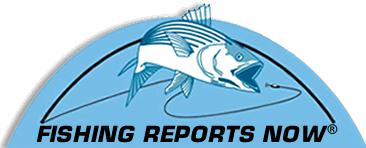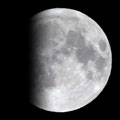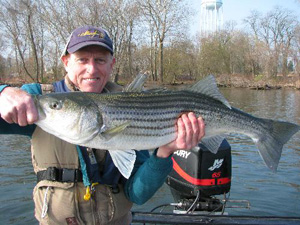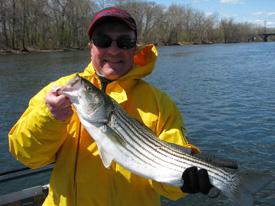Thermometer Rising on the Big D |
||
|
The Delaware River is like the thermometer of springtime fishing. When the first striped bass of the season start to be caught on the lower river, south of Philadelphia, such as from the banks of Salem, the spring migration is heating up all along the New Jersey Coast. By the time the stripers push So all eyes are locked on the river But not just because the river marks the entire season’s progress. It’s also simply because the river’s striper bite can be like 110 degrees in the shade. Hot. That's because few waters force stripers, some of the biggest ones going, large, mature breeders, to funnel through a narrow, tight area like the river does. So when does the run kick off? |
|
The best fishing coincides with the herring migration on the river. Herring usually start to run the Delaware in early April and keep arriving through the third or fourth week of May. Shad, anadromous fish like herring and stripers, also come up the river in spring, and the scrappy fighters make up a sport fishery themselves. The “poor man’s salmon,” anglers call the shad. But that’s another fish story. All three of the fish migrate through the river at once, Chris believes. During some years one might arrive before another, but generally they make one concerted push. Likewise he believes that all different sizes of striped bass migrate through the river at once. Anglers might think that certain sizes arrive first, but Chris has experienced no consistent pattern.
The linesiders will often swim the river in groups of different sizes and age classes, but it’s probably haphazard, no logic like smaller fish first. Most of the stripers are 15 pounds, but bigger ones aren’t uncommon. Migrating stripers can also come up the river when the water’s too cold for them to bite. This year they started swimming the river when the waters were 40 to 45 degrees, preventing them from smacking bait. Chris can catch the bass when the water rises to 48 degrees. But inexperienced anglers will go hitless. The fish usually bite best when the river reaches 54 to 56 degrees. During the third week of April, when this article was posted, the waters ranged 52 to 53, and a major influx of herring showed up for the first time in the season. The stretch of the river from Trenton north to Lambertville and New Hope is the spawning grounds for many of the stripers. That’s where Chris fishes the run. But the fish also spawn elsewhere, including farther south on the tidal flats downriver from the Commodore Barry Bridge. The herring and shad are also spawning at various areas of the river. Many of the herring spawn at the same places as the stripers, and the shad seem mostly to spawn farther upstream. New Jersey’s Fish and Wildlife Division frowns on fishing for stripers in the area that’s closed to possessing them from April through May: from Trenton’s Calhoun Street Bridge south to the Salem River. The government wants to protect the spawning fish. However, lots of the state’s anglers fish the run there, playing catch and release. But Chris concentrates on the waters farther north, where the season is open during the run. Fishing for the stripers is simple, he said. It’s all about the herring, because the stripers are predominantly feeding on the baitfish. If anglers can figure out where to find the herring, they can catch the stripers. Herring are looking for the easiest route to swim. So Chris targets waters like current seams, such as an edge of slow water along fast water, maybe the edge of a flat along current, maybe simply an area where the water funnels along a boulder, or anyplace that’s likely to concentrate herring that are migrating. Outside river bends are productive. Some pockets and holes consistently produce stripers, but the fishing’s about the herring, and Chris believes the bass are following the herring instead of lying in wait. If anglers are trout fishers used to determining likely spots to drop a line to trout in rivers or streams, the striper fishing’s about the same concept. Experienced trout anglers will figure out the best spots just fine.
They impale the herring on a 6/0 or 7/0 Owner SSW hook, a non-offset circle hook. The hooks are tied to a 30-pound fluorocarbon leader attached to a swivel that’s attached to the main line, usually 17-pound test. Chris determines the length of the leader, anywhere from 20 inches to 36 inches, according to the angler’s height and casting ability. A tall person who’s a decent caster uses a longer leader, and vice versa. The bait is fished right along the bottom. Chris uses no weight with the bait when the boat is drifting, and he often drifts. But weight is used when anchored, because then the current will pull the line upward in the water column. A fish-finder rig is used to attach weight to the line. Up to 4 ounces normally holds bottom. Anglers with Chris use 7-foot Shimano Trevala spin-fishing rods built for butterfly jigging. Butterfly jigging is a whole different type of fishing, but Chris discovered that the soft action of the rods works well with circle hooks in the river’s currents. With circle hooks, the angler doesn’t set the hook but instead lets the line come tight and reels after a bite, so the hook turns in the fish’s mouth and sets itself. The angler lets the fish take the bait for a three or four count before reeling. The hook set is one of the most important factors in the fishing. Lots of variables including the current and the drift come into play in setting the hook, and the soft, forgiving action of the Trevala rods—the gradual, even loading—helps. Chris uses spinning reels, baitcasters to be specific, but only because charters are often more comfortable using spinning than conventional reels. Ardent Angler’s charters, like most anglers fishing the run, usually start with catching herring for bait at the beginning of the trip. The anglers enjoy the experience. Charters with Chris jig the herring with three-hooked Sabiki rigs. The herring are kept alive in a baitwell with water that’s constantly replaced. After the stripers spawn, they swim back down the river, through Delaware Bay and to the ocean, then head north for cool waters That's the dropping mercury in the thermometer of the entire spring migration of fish. But the fishing, especially on the river, sure was good while it lasted. |
||



 Big, mature females are the migrating stripers that anglers look forward to most. But different sizes of mature stripers, such as younger, leaner, smaller males, also migrate.
Big, mature females are the migrating stripers that anglers look forward to most. But different sizes of mature stripers, such as younger, leaner, smaller males, also migrate. Charters with Ardent Angler fish for the stripers with mostly livelined herring. But they also dunk chunked or whole, dead herring.
Charters with Ardent Angler fish for the stripers with mostly livelined herring. But they also dunk chunked or whole, dead herring.